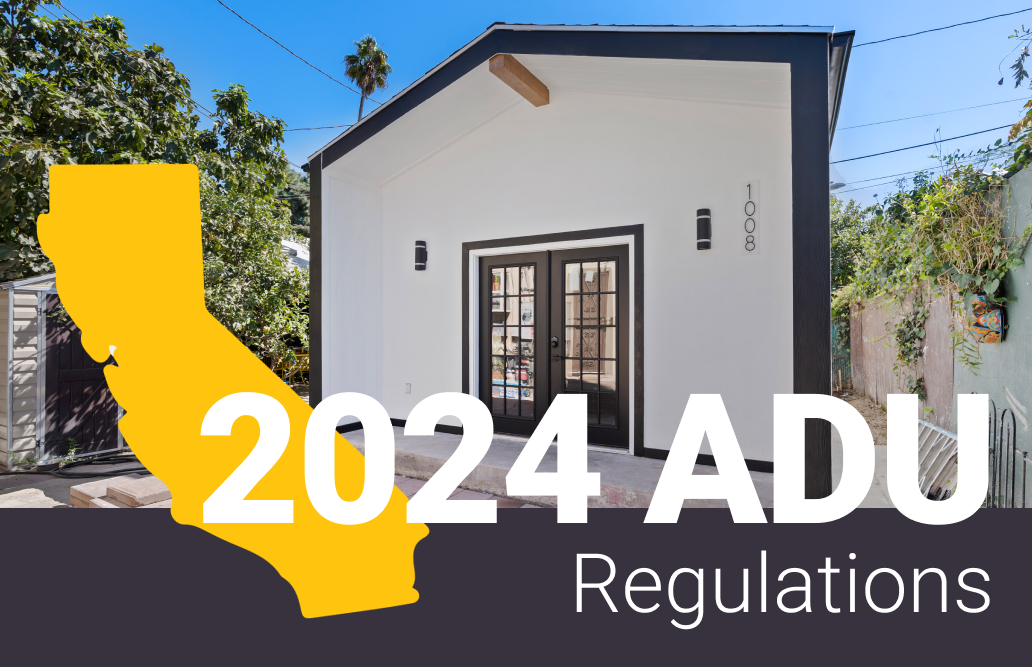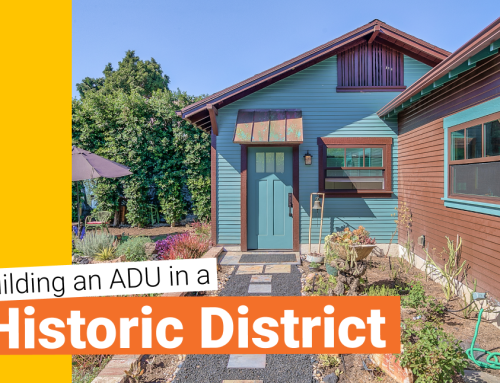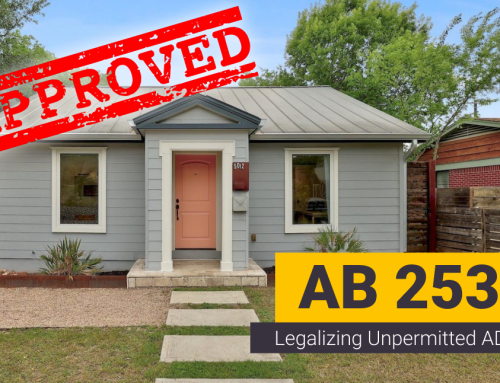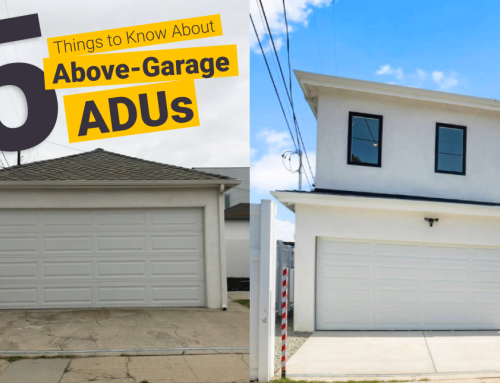Note: This blog covers 2024 regulations. For the latest updates in 2025, click here!
New year, new ADU regulations!
If building an ADU is on your resolutions list, there are few things that will help you more than having a strong understanding of state regulations. A lot has changed in just the last few years. Even in 2023 we saw some incredible changes come down the pipeline. But, with any new wave of changes there can be a lot of confusion about what’s allowed and what isn’t. Strap in because we’re here to set the record straight.
What is an ADU?
ADU stands for accessory dwelling unit. The definition lies in the name. An ADU is meant to be an accessory structure to the main residential structure on the property. Different from guest houses, ADUs are meant for long-term housing, so they must be built with the following:
- A permanent foundation
- Separate entrance from the main house
- Full kitchen including stove, countertops, and sink
- Full bathroom with toilet and shower or bath
- Bedroom or adequate space for a bed if building a studio
- Insulation
- Utility connections (sewage, water, electricity, etc)
What’s new in 2024?
California is one of the few states in the US that has passed statewide ADU regulations. The government recognizes the benefits and these dwelling units and policymakers continue to make modifications to these regulations every year to make it easier for homeowners to add an ADU to their properties, increasing the housing supply. Let’s take a look at some of those changes.
Owner Occupancy is a thing of the past
Owner occupancy refers to a requirement that if a homeowner builds an ADU, they must live on the property, either in the ADU or the main residence. The owner occupancy requirement has been permanently eliminated in California thanks to AB 976.
This will come as a big relief for homeowners that are looking to turn their properties into an investment piece. Back in 2020, SB 13 paved the way for Ting’s AB 976. SB 13 banned the owner occupancy requirement until 2025, but after hearing of the high demand to continue this ban, the government agreed to extend it indefinitely. Big win!
Although, we should mention that JADUs, junior accessory dwelling units, are still subject to owner occupancy.
Condo-ized ADUs
This is a big one! ADUs can now be sold separately from the main residence through a process called condo-ization.
This potential change represents a notable shift, providing an additional option for property owners and potentially facilitating more flexible homeownership structures. The US Census Bureau reported that household sizes have shrunk to 3.1 persons in 2021, down from 3.7 in the 60s and continues to decline. First time homebuyers are finding that many homes in the market are larger than what’s needed, making them difficult to afford.
The bill aims to enhance housing opportunities. Allowing ADUs to be sold separately opens up a new market of smaller sized homes that meet the requirements of new families at the fraction of the cost of larger homes.
However, this bill is leaving it up to the individual cities to decide if they want to allow citizens to condo-ize their ADUs. As of this update, only one city, San Jose, has passed an ordinance to allow it.

California ADU Regulations in 2024
Now with the newest changes out of the way, we can dive into the comprehensive guide of all the important ADU regulations you need to know. Keep in mind that jurisdictions can pass ordinances to modify some of these regulations as long as they are not more restrictive.
Allowed ADU Types
Every residential property in California is allowed to have one ADU of up to 800 sq ft regardless of lot size, floor area ratio, or main residence size. This ADU can be up to 16 ft in height.
If space permits, state regulations allow you to build one attached ADU, one detached ADU, and one JADU all on the same property.
ADUs can be converted from almost any accessory structure or space on the property including garages, attics, and basements. ADUs can also be built above garages.
ADU Sizes
In California, cities must allow at least 850 sq ft for one bedroom ADUs and at least 1,000 if the ADU has two or more bedrooms. Cities cannot impose smaller max sizes, but they can impose larger. For cities without ordinances, max size is set to 1,200 sq ft for detached ADUs and up to 50% of the floor area of the existing main residence for attached ADUs.
However, remember you are always allowed an 800 sq ft ADU. For example, if your main residence is only 1,400 sq ft (your attached ADU would only be 700 sq ft under the 50% rule) you are still entitled to an 800 sq ft ADU.
Garage conversion ADUs do not have a size limit, as long as you stay within the existing footprint. For example, if you have a 2,000 sq ft barn on your property, the entire structure can be converted as long as you do not expand the existing footprint.
Setbacks
Setbacks refer to the distance of the ADU to the edge of the property. For ADUs, setbacks can be up to 4 feet from the side and rear. Some cities, like San Diego, have even passed ordinances that allow 0 ft side and rear setbacks.
Front setbacks depend on your jurisdiction, however, if your city’s front setback requirements hinder your ability to build an 800 sq ft ADU on your property, front setbacks cannot be enforced. This is known as a state exemption.

ADU Heights
16 ft must be allowed for every ADU in California under any circumstance.
Other scenarios that would allow higher ADUs include:
- 18 ft is allowed if the ADU is within half a mile walking distance from public transit like a bus stop or train station. This height is tall enough to accommodate two stories.
- 18 ft is also allowed if the property already has a multi-family dwelling that is two stories high.
- 25 ft is allowed if the ADU is going to be attached to the main residence, regardless of its height. Note that this will also depend on your local underlying zoning code. Whichever is lowest will apply.
Parking
Off-street parking is required for ADUs (one per unit or bedroom) except in the following circumstances:
- The ADU is located within half a mile walking distance from public transit
- The ADU is located within an architecturally or historically significant district
- The ADU is converted from an existing space or accessory structure
- On-street parking permits are required but not offered to the occupant of the ADU
- A car share vehicle is located within one block of the ADU
Similarly, if you are converting your garage, your city cannot require you to replace the lost off-street parking space.

FAQs
Is the CalHFA ADU Grant still in service?
As of January 2024, the $40k ADU Grant is no longer available. In December of 2023, $25 million was approved by the government to be added to the pool. Because of high demand, the pool was drained in just a matter of days.
We have high hopes that the grant will return in the near future. The $40k grant has proven to be a valuable resource to homeowners looking to build an ADU.
What happens if my city hasn’t updated its ADU ordinances to reflect new state regulations?
If your city has not adopted the latest state ADU regulations, consult your ADU designer first. They are best equipped to challenge any local rules that conflict with state law, especially if this is preventing you from obtaining your building permit. If your local planning department refuses to comply, your designer can report them to the Department of Housing and Community Development (HCD). The HCD has the power to fine or sue noncompliant cities and enforce adherence to state regulations, ensuring your project moves forward in accordance with the law.
How do I know if my property is eligible for an ADU?
If you own residential or multi-family property, odds are you are eligible to build an ADU on your property. State law states that every California homeowner is allowed to build at least one 800 sq ft ADU on their property regardless of lot size, floor-area-ratio, and front setbacks. These are known as “66323 units” in reference to the Government Code that this law originates from.
Does my ADU need to have fire sprinklers?
Fire sprinklers are only required in the ADU if they are required in the primary home.
Further, building an ADU on your property will not trigger a group R occupancy change, which would have required fire sprinklers.
Are ADUs allowed on multi-family properties?
Yes, ADUs are allowed on multi-family properties, including apartment complexes and duplexes.
Every multi-family property is allowed at least one ADU converted from an existing space in the primary structure and one detached ADU per existing living unit, capped at eight. For buildings with 8 or more units, you are also allowed to add up to 25% of the number of units in your building.
Does my ADU need to have solar panels?
Properties with a new built detached ADUs must have solar panels either on the ADU itself or on the main house. Modular or prefab ADUs are exempt from this requirement.
Maxable is the trusted ADU resource
Maxable is the leading ADU resource for a reason. Our team is passionate about educating homeowners to make the ADU building process seamless while saving you valuable time and money.
Get connected to vetted ADU professionals in your area and get started on completing your New Years Resolution today.









